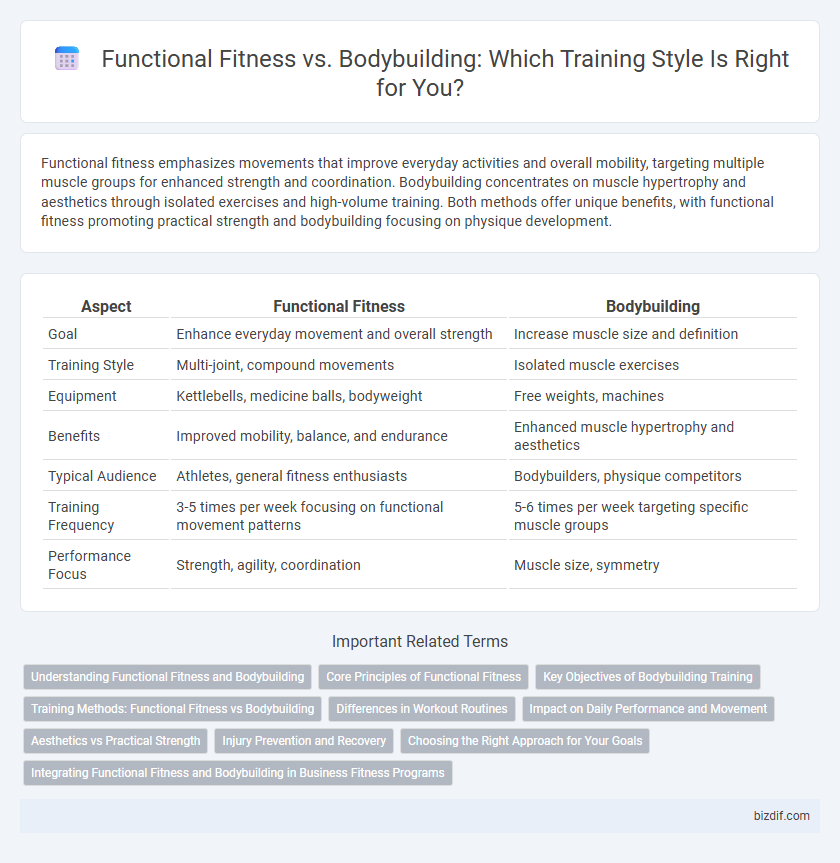Functional fitness emphasizes movements that improve everyday activities and overall mobility, targeting multiple muscle groups for enhanced strength and coordination. Bodybuilding concentrates on muscle hypertrophy and aesthetics through isolated exercises and high-volume training. Both methods offer unique benefits, with functional fitness promoting practical strength and bodybuilding focusing on physique development.
Table of Comparison
| Aspect | Functional Fitness | Bodybuilding |
|---|---|---|
| Goal | Enhance everyday movement and overall strength | Increase muscle size and definition |
| Training Style | Multi-joint, compound movements | Isolated muscle exercises |
| Equipment | Kettlebells, medicine balls, bodyweight | Free weights, machines |
| Benefits | Improved mobility, balance, and endurance | Enhanced muscle hypertrophy and aesthetics |
| Typical Audience | Athletes, general fitness enthusiasts | Bodybuilders, physique competitors |
| Training Frequency | 3-5 times per week focusing on functional movement patterns | 5-6 times per week targeting specific muscle groups |
| Performance Focus | Strength, agility, coordination | Muscle size, symmetry |
Understanding Functional Fitness and Bodybuilding
Functional fitness emphasizes exercises that mimic everyday movements to improve overall strength, coordination, and balance, enhancing practical performance and injury prevention. Bodybuilding concentrates on hypertrophy training, aiming to increase muscle size and definition through targeted resistance exercises and structured nutrition plans. Understanding these distinctions helps tailor fitness goals, whether prioritizing functional movement or aesthetic muscle development.
Core Principles of Functional Fitness
Functional fitness emphasizes training movements that mimic real-life activities to improve overall mobility, balance, and strength, prioritizing compound exercises like squats, lunges, and kettlebell swings. Its core principles include developing multi-joint, multi-muscle coordination and enhancing neuromuscular efficiency to support daily functional tasks and injury prevention. Unlike bodybuilding, which focuses on muscle size and isolation, functional fitness aims to optimize performance and functionality in both athletic and everyday settings.
Key Objectives of Bodybuilding Training
Bodybuilding training primarily aims to increase muscle size, symmetry, and definition through targeted resistance exercises and hypertrophy-focused routines. Its key objectives include muscle mass development, sculpting specific muscle groups, and enhancing muscular endurance for aesthetic purposes. Bodybuilders often follow structured training splits and nutritional plans to optimize muscle growth and reduce body fat for enhanced physical appearance.
Training Methods: Functional Fitness vs Bodybuilding
Functional fitness training emphasizes multi-joint movements that mimic daily activities, enhancing overall mobility, balance, and core stability through dynamic exercises like kettlebell swings and bodyweight squats. Bodybuilding training focuses on isolated muscle groups using resistance machines and free weights to maximize muscle hypertrophy and definition through controlled, repetitive sets. While functional fitness integrates compound, full-body workouts to improve practical strength, bodybuilding prioritizes muscle symmetry and volume through targeted muscle engagement.
Differences in Workout Routines
Functional fitness routines emphasize multi-joint movements that improve everyday activities, incorporating exercises like kettlebell swings, squats, and push-ups to enhance strength, balance, and flexibility. Bodybuilding workouts focus on isolating specific muscle groups through exercises such as bicep curls, bench presses, and leg extensions to maximize muscle hypertrophy and definition. Functional fitness promotes overall mobility and endurance, while bodybuilding prioritizes targeted muscle growth and aesthetic development.
Impact on Daily Performance and Movement
Functional fitness enhances daily performance by improving strength, balance, and coordination through compound, multi-joint movements that mimic real-life activities. Bodybuilding primarily focuses on muscle hypertrophy and aesthetic development, often isolating muscles, which may not translate as effectively to practical movement or flexibility. Emphasizing functional fitness supports efficient, injury-resistant movement patterns critical for everyday tasks and overall mobility.
Aesthetics vs Practical Strength
Functional fitness emphasizes practical strength by training movement patterns that improve everyday activities and athletic performance, enhancing core stability, balance, and flexibility. Bodybuilding prioritizes aesthetics through hypertrophy-focused workouts aimed at muscle size, definition, and symmetry, often isolating specific muscle groups. While bodybuilding sculpts the physique for visual appeal, functional fitness develops versatile strength for real-world functionality and injury prevention.
Injury Prevention and Recovery
Functional fitness emphasizes multi-joint movements that improve real-life activity performance, significantly reducing injury risk through enhanced mobility, balance, and coordination. Bodybuilding concentrates on muscle hypertrophy and symmetry, which may increase injury risk if movement patterns are neglected or imbalanced muscle development occurs. Incorporating functional training into bodybuilding routines supports injury prevention and accelerates recovery by promoting joint stability and muscular endurance.
Choosing the Right Approach for Your Goals
Functional fitness emphasizes practical movements that improve everyday activities and overall mobility, making it ideal for those seeking enhanced real-world strength and injury prevention. Bodybuilding focuses on muscle hypertrophy and aesthetic development through targeted resistance training, suited for individuals aiming to increase muscle size and definition. Selecting the right approach depends on personal goals, whether optimizing performance and functionality or achieving sculpted muscle growth.
Integrating Functional Fitness and Bodybuilding in Business Fitness Programs
Integrating functional fitness and bodybuilding in business fitness programs enhances employee performance by combining strength, endurance, and practical movement skills, promoting overall health and injury prevention. Corporate wellness initiatives benefit from hybrid training models that improve workplace productivity through increased mobility, muscular strength, and cardiovascular fitness. Implementing personalized workout plans blending functional exercises and bodybuilding techniques fosters sustainable fitness habits and reduces absenteeism in professional environments.
Functional Fitness vs Bodybuilding Infographic

 bizdif.com
bizdif.com